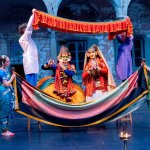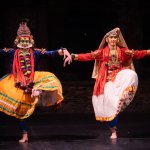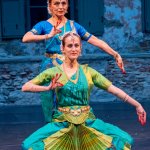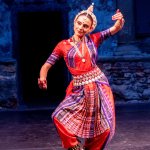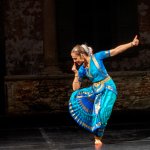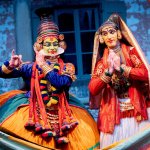A mixing of Indian classical dance-theatre
Following the path of the 20th century’s Masters, in 1978 Teatro Tascabile di Bergamo started its personal research line on the Eastern scenic arts and, in particular, on the Indian classical dance-theatre as a way for a complete renewal of the theatre as well as of the art of the actor.
As testified by the archeological findings of the Mohenjodaro’s valley in Pakistan (2900-1900 B.C.), Indian classical dances claim very ancient origins. Due to a long chancing process lasted over the centuries, the temple where priestesses used to dance, becomes the fulcrum of the religious, social and artistic life. However, during the Middle-Age, following the coming of Muslims from the North, dancers weren’t anymore just part of the rituals. They became, invited to the courts, enchanting entertainers for nobles and sovereigns.
Since the second half of the 19th century and until the first decades of the last century, Indian classical dances were involved into a general state of decay which actually occurred to the whole Indian culture while ruled by the English Crown. Once India gained its independence (1948), these dances restored their earlier splendor, adding a growing vitality and popularity.
“Eastern Kaleidoscope” is a mixing of extracts by the two disciplines continuously practiced at Tascabile: Bharata Natyam, Kathakali and Orissi.
Their common denominator is the rigor of the technique and the legendary training of the actors as it is described by the NÄtyaÅ›Ästra, “ancient treatise on the arts”. This is the most important theoretical text on the Indian classical theatre which, for its relevance in the theatrical Esthetic, could be compared to the Aristotele’s Poetics and the Zeami’s treatises.
According to the principles of the Indian classical dance-theatre, the most direct way to approach it is to consider the partition in two fundamental parts: pure dance (nritta) and acting (abhinaya) with a special attention to that sort of very high stylization mimic language, which is technically defined nritya or expressive dance.
BHARATA NATYAM: is the classical Indian dance par excellence. In ancient times it was performed in temples by holy dancers, the devadasi, who were brought up and instructed in the arts and music solely for this purpose.
Bharata Natyam is an acronym made by three syllables: bha for bhava, the feeling, ra for raga, the melody, and ta for tala, the rhythm.
The Bharata Natyam’s cradle is in the South India, more precisely Tamil Nadu, where it took life in the district of Tanjore.
KATHAKALI: originally from Kerala in south-western India, Kathakali distilled the juices of a multiform culture of spectacular practices and rituals until it was organized in its final and present form around the mid-eighteenth century. On that time the Rajah of Kottarakkara composed the majority of the repertoire taking inspiration by the Indian classical epics of Ramayana, Mahabharata and Purana.
The kathakali word literarely means a telling of actions (katha=story, kali=telling) , accordingly it is more appropriate to define Kathakali like a form of theatre-dance-pantomime rather than just theater or just dance.
ORISSI: whose name comes from the homonymous Indian State of Orissa, was born from the meeting of two traditions: the mahari’s one, dancers-priestesses of Jagannath, and the Gotipua’s one, very young male dancers which, dressed like females, used to perform outside the temple’s wall.
It is a very refined and elegant style because of its sculptural poses: it refers to the classical tradition of the Indian dance-theatre as well as to the indigenous styles influenced by the presence of the muslim dominion of moghul.









